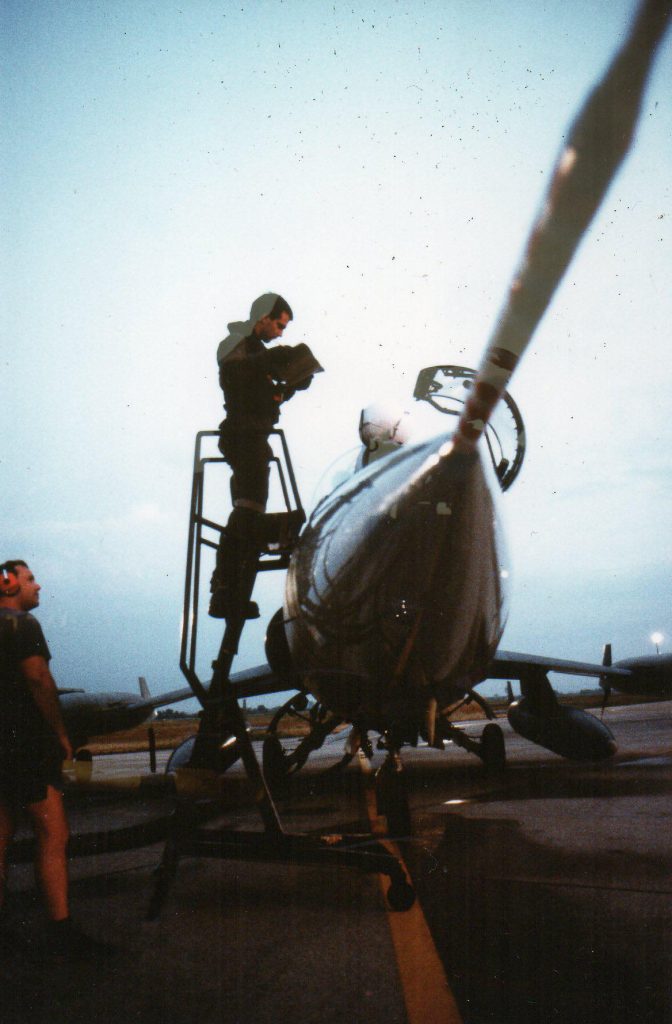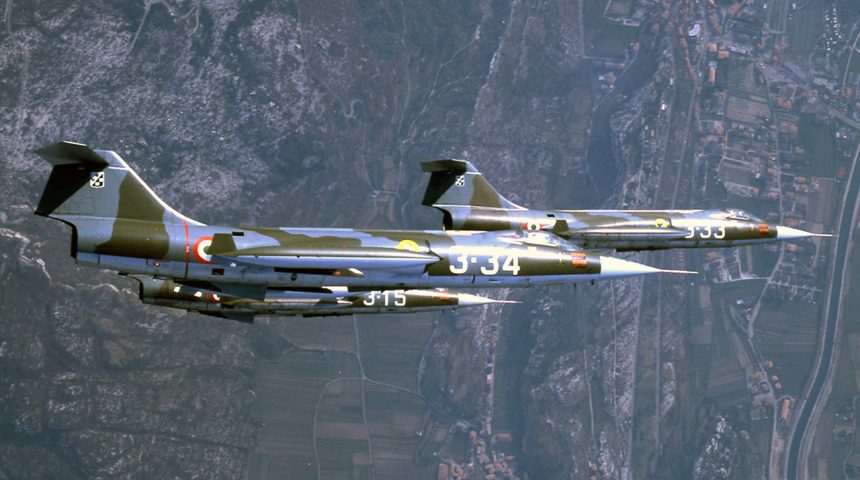The thrills of formation aerobatics in the legendary F-104 Starfighter.
Here I am, in the cockpit of an F-104G of the 28° Gruppo (Squadron) belonging to the 3° Stormo (Wing), of the Aeronautica Militare (Italian Air Force) working my butt off to maintain position while “il Nonno” [Italian for “The Grandpa”, the pilot’s nickname] is sewing the sky above Villafranca Air Base with a series of aerobatic maneuvers that the Frecce Tricolori (the Italian Air Force aerobatic display team) got nothing on him.
A left hand barrel roll, then one to the right, just to make me feel the thrill of being on the inner and the outer side of the maneuver, then we go up for a nice loop: “A/B, A/B… NOW!”. My left hand, on the throttle, makes the classic movement, outboard first and then forward, to switch from MILITARY to afterburner power and I feel the reassuring kick in the butt that confirms me that the A/B has actually kicked in (no time to check the engine’s instruments); all this while “Grandpa” is nailing 4 Gs and a half and I bite his wing as best as I can.
There were two possible ways of doing aerobatics with the F-104.
The “classic” way was taught at the “Twentieth” (the 20° Gruppo – the Italian Air Force OCU squadron for the Starfighter in those years): the afterburner was not to be used, but you had to work the flaps, in the vertical maneuvers, from UP to TO with decreasing airspeed (right about 300 knots) and, viceversa, from TO to the UP position with speed increasing through 400 knots.
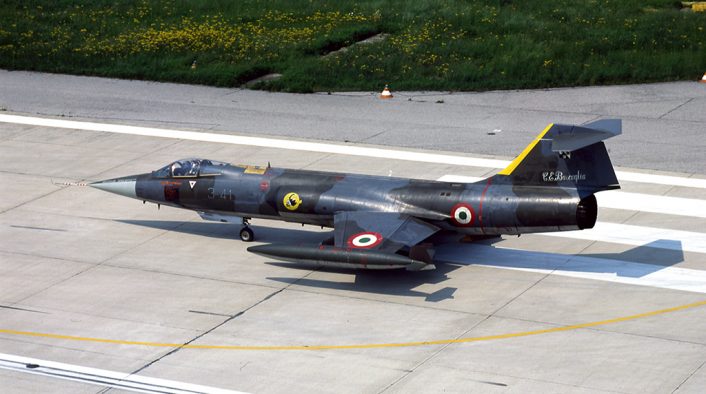
This flap movement represented a challenge: first, you had to find the flap lever right away (not easy when you are still a student); second, you had to move it in the correct direction (I know it sounds obvious but, believe me, it was not); third, flap transition from one position to the other, either way, modified the trim situation, so the tendency was to over-control in pitch, getting close to that dark and sad place know to all pilots as PIO (Pilot Induced Oscillations).
The leader of a two-ship formation can see right away, on his rearview mirror, his wingman transitioning from one flap position to the other: his aircraft start pitching quite rapidly for a few seconds, before stabilizing itself. All this while going through the vertical, pulling 4 Gs while the student’s aircraft is “dancing” few feet from your wingtip. Cold sweat stuff, I tell you.
Experience would then teach you to leave the aircraft a bit “pitch heavy” with the trim, to avoid a too “light” stick that could cause, in turn, excessively wide corrections and, subsequently, PIO.
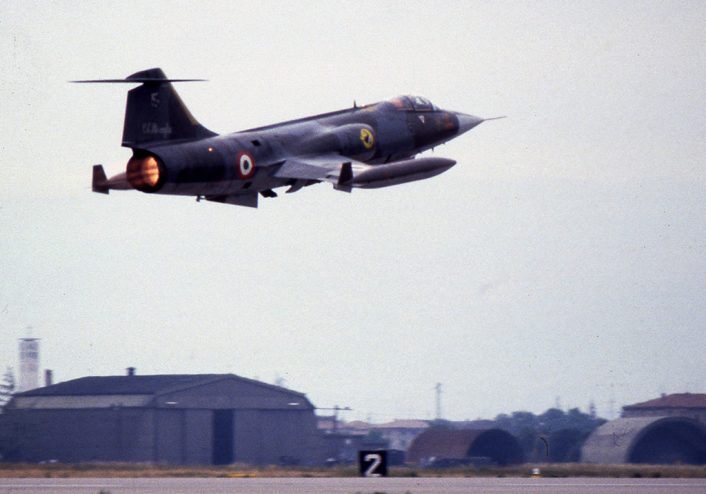
Anyway, this was the technique you were taught, as a very young and green 2nd lieutenant, in the Scansano and Gavorrano areas, when you were under the claws of the “Lions” of the 20th Squadron.
But the two seater TF-104 was a bit lighter than the single seat F-104. Configuration for all instructional missions was pretty much always the same, with just the tip tanks, and you could play with the flaps instead of the afterburner to save a bit of fuel for a few more touch and goes later on.
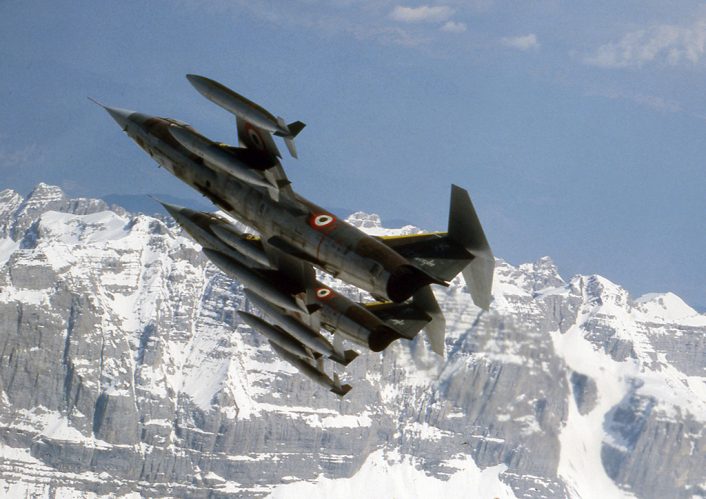
At the squadrons it was different.
The G and the S were heavier and you had to play with whatever configuration you had that particular day: quite often (almost always) at “Villa” [Villafranca AB] you had the “bin” (the Orpheus recce pod) under your belly and, also, the pylons tanks under your stubby wings; aerobatics were, of course, much more “Interesting”.
So, formation aerobatics could be more “manly”: flaps could be kept in the TO position and the A/B could be used as if there was no tomorrow.
The “FLAPS, TO… NOW!” radio call was substituted by “A/B, A/B… NOW!” And, viceversa, “FLAPS, UP… NOW!” by “A/B, OUT… NOW!”. Quite often, there was no radio call at all: you just had to hang on just knowing, more or less, what was coming up next.
All the young lieutenants in the fighter squadrons of the Aeronautica Militare were dreaming to hear, one day, in their helmet headphones the call “SMOKES; SMOKES… NOW!” [used by the Frecce Tricolori], but that’s another story.
But let’s go back to the sky above Villafranca with yours truly flying an F-104 of the 28° Gruppo (Squadron).
I am working, I was saying, my butt off while “Grandpa” is painting aerobatics with me hanging on his wing. Sweat is pouring in my eyes as I pull Gs trying to maintain my position and, at the same time, to keep spatial orientation i.e. where is the sky and where is the hard ground. My G-suit inflates, squeezing my legs, to avoid greying out (no good while flying formation aerobatics) while I swear the Virgin Mary and all the Saints trying not to fall back, not too much anyway.
It’s a stage, guys! The “Streghe” (Witches) of my squadron are out on the apron, hands on the foreheads to shield the eyes from the sun, to see how the rookie 2nd lieutenant is doing while being worked out by “Grandpa”; and, worse, the hated “Grappe” [from Grappa, the radio callsign of the 132° Gruppo] of our sister squadron, the 132°, are also out there to criticize the two “Streghe” [Italian for Witches – from the 28° Gruppo’s radio callsign “Strega”] that are drilling holes over the vertical of the airfield. All of them, but one….
Here I am, therefore, biting my leader wing, drenched in sweat, swearing under my breath while trying not to think of all the eyes on me, when “Grandpa” starts pulling up for another loop. “A/B, A/B… NOW!”, kick in my butt, 4.5 Gs to keep the airspeed under 450 kts and we point our pitots toward the vertical.
Passing the vertical… “A/B, A/B… OUT!”. “Now? Isn’t it too early? Man, we are going to go ballistic!”. All these thoughts in a flash while my left hand, obedient, pulls out the throttle from the A/B position and my beautiful formation becomes a 6 seconds trail because, at the same time, I realize that:
- “Grandpa” is out of afterburner, my ass!
- the one on the radio was not his so characteristic, roman voice!
“Shit, shit, SHIIIIT…” I think.
But it’s too late and the damage is done.
I can picture the damned “Grappe” rolling around with laughter while one of them, diabolic, lowers the handmike of their Squadron Operation Room radio, used to give me the fake command.
I rejoin on the “Grandpa”’s 104 and I see him shaking sadly his helmet while, I just know that, he is grinning under his oxygen mask.
Walking back to the squadron building, seraphic, he just doesn’t hear my childish whining. “Consoli” he patronizes me with is characteristic drawl, “you gotta recognize your leader’s voice!”
This is, sadly, a true story.
